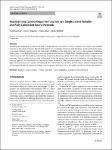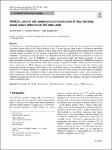Search
Author
- Ackerman, Gary L (1)
- Adrián, Sánchez-Caballero (1)
- Ahmad, Karim (1)
- Ahmed, Eldawy (1)
- next >
Subject
- 2N labeling defense me... (1)
- A primal-dual splittin... (1)
- algorithmic judges (1)
- ANFIS (1)
- next >
Has File(s)
- true (39)
Search Results
My purpose in writing this book is to give readers a view into the work of managing information technology in schools. IT professionals will notice differences (some nuanced and some significant) between the needs and expectations of IT users in business and IT in school. With the more complete and more accurate concept the nature of the computing environment necessary for successful schooling, which I intend to provide through this book, IT professionals will be better prepared to meet those needs. Educators will also benefit from this book by clarifying the nature of their IT needs and how these may be different from those that are familiar to IT professionals who are hired to work in your school. |
Programming patterns are solutions to problems that require the creation of a small fragment of code that will be part of a larger program. Hence, this book is about teaching you how to write such fragments of code. However, it is not about teaching you the syntax of the statements in the fragments, it assumes that you already know the syntax. Instead, it is about finding solutions to problems that arise when first learning to program. |
Let S⊆Rn be a compact semialgebraic set and let f be a polynomial nonnegative on S. Schmüdgen’s Positivstellensatz then states that for any η>0, the nonnegativity of f+η on S can be certified by expressing f+η
as a conic combination of products of the polynomials that occur in the inequalities defining S, where the coefficients are (globally nonnegative) sum-of-squares polynomials. It does not, however, provide explicit bounds on the degree of the polynomials required for such an expression. |
Judgments concerning animals have arisen across a variety of established practice areas. There is, however, no publicly available repository of judgments concerning the emerging practice area of animal protection law. This has hindered the identification of individual animal protection law judgments and comprehension of the scale of animal protection law made by courts. Thus, we detail the creation of an initial animal protection law repository using natural language processing and machine learning techniques. This involved domain expert classification of 500 judgments according to whether or not they were concerned with animal protection law. 400 of these judgments were used to train various models, each of which was used to predict the classification of the remaining 100 judgments... |
The increasing size of deep neural networks (DNNs) raises a high demand for distributed training. An expert could find good hybrid parallelism strategies, but designing suitable strategies is time and labor-consuming. Therefore, automating parallelism strategy generation is crucial and desirable for DNN designers. Some automatic searching approaches have recently been studied to free the experts from the heavy parallel strategy conception. However, these approaches all rely on a numerical cost model, which requires heavy profiling results that lack portability. These profiling-based approaches cannot lighten the strategy generation work due to the non-reusable profiling value. Our intuition is that there is no need to estimate the actual execution time of the distributed training bu... |
Representing Camera Response Function by a Single Latent Variable and Fully Connected Neural Network Modelling the mapping from scene irradiance to image intensity is essential for many computer vision tasks. Such mapping is known as the camera response. Most digital cameras use a nonlinear function to map irradiance, as measured by the sensor to an image intensity used to record the photograph. Modelling of the response is necessary for the nonlinear calibration. In this paper, a new high-performance camera response model that uses a single latent variable and fully connected neural network is proposed. The model is produced using unsupervised learning with an autoencoder on real-world (example) camera responses. Neural architecture searching is then used to find the optimal neural network architecture. A latent distribution learning approach was introduced to constrain the latent... |
In the digital age, the use of advanced technology is becoming a new paradigm in police work, criminal justice, and the penal system. Algorithms promise to predict delinquent behaviour, identify potentially dangerous persons, and support crime investigation. Algorithm-based applications are often deployed in this context, laying the groundwork for a ‘smart criminal justice’. In this qualitative study based on 32 interviews with criminal justice and police officials, we explore the reasons why and extent to which such a smart criminal justice system has already been established in Switzerland, and the benefits perceived by users. Drawing upon this research, we address the spread, application, technical background, institutional implementation, and psychological aspects of the use of ... |
Artificial Intelligence and algorithms are increasingly able to replace human workers in cognitively sophisticated tasks, including ones related to justice. Many governments and international organizations are discussing policies related to the application of algorithmic judges in courts. In this paper, we investigate the public perceptions of algorithmic judges. Across two experiments (N = 1,822), and an internal meta-analysis (N = 3,039), our results show that even though court users acknowledge several advantages of algorithms (i.e., cost and speed), they trust human judges more and have greater intentions to go to the court when a human (vs. an algorithmic) judge adjudicates. |
In clinical practice, algorithmic predictions may seriously jeopardise patients’ health and thus are required to be validated by medical experts before a final clinical decision is met. Towards that aim, there is need to incorporate explainable artificial intelligence techniques into medical research. In the specific field of epileptic seizure detection there are several machine learning algorithms but less methods on explaining them in an interpretable way. Therefore, we introduce XAI4EEG: an application-aware approach for an explainable and hybrid deep learning-based detection of seizures in multivariate EEG time series. In XAI4EEG, we combine deep learning models and domain knowledge on seizure detection, namely (a) frequency bands, (b) location of EEG leads and (c) temporal char... |
A crime scene can provide valuable evidence critical to explain reason and modality of the occurred crime, and it can also lead to the arrest of criminals. The type of evidence collected by crime scene investigators or by law enforcement may accordingly effective involved cases. Bullets and cartridge cases examination is of paramount importance in forensic science because they may contain traces of microscopic striations, impressions and markings, which are unique and reproducible as “ballistic fingerprints”. The analysis of bullets and cartridge cases is a complicated and challenging process, typically based on optical comparison, leading to the identification of the employed firearm. New methods have recently been proposed for more accurate comparisons, which rely on three-dimensi... |










